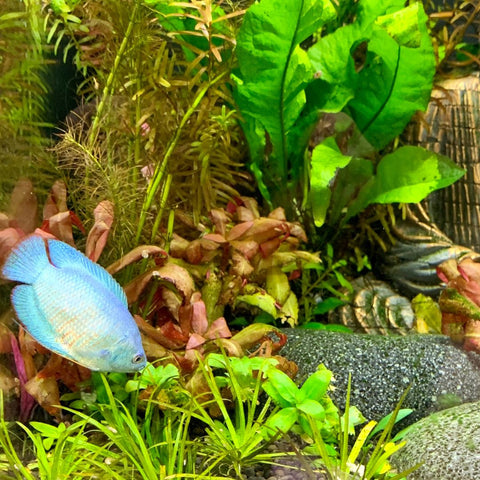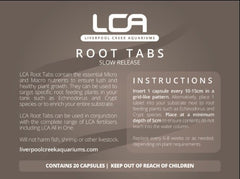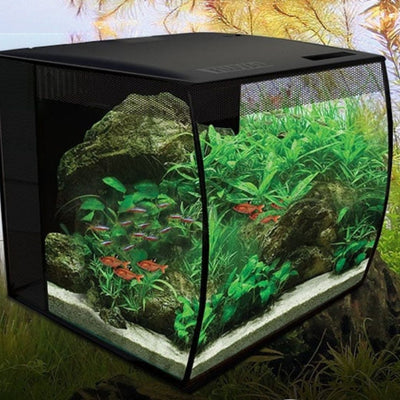
Do you want healthy looking plants in your aquarium? If so, choosing the right plant food is essential. With numerous options available in Australia, finding the best aquarium plant food can be a daunting task. Don't worry, though, because we've got you covered.
Many people don't give the health of their aquatic plant a second thought, often thinking that once planted, they have everything they need. In this comprehensive guide, we will delve into the world of aquarium plant food and help you know the correct one to choose for your aquarium plants. We will explore different types of plant food, their benefits, and what to consider when choosing the best one for your fish tank.
From liquid fertilisers to root tablets, we'll break down each option and explain how they contribute to optimal plant growth. Whether you have a freshwater or a planted tropical tank, we can also provide you with advise in store from our knowledgeable team.
Importance of Aquarium Plant Food
Aquarium plant food plays a crucial role in maintaining a thriving aquatic ecosystem. Just like plants on land, aquarium plants also require essential nutrients to grow and flourish. While fish waste and decaying organic matter can provide some nutrients, they are often insufficient to meet the plants' needs. This is where aquarium plant food comes into play.
Proper nutrition is essential for optimal plant growth. Without the necessary nutrients, plants can become weak, wilt, or even die. Additionally, healthy plants contribute to a balanced ecosystem by oxygenating the water, absorbing excess nutrients, and providing shelter for fish and other aquatic creatures.
By providing your aquarium plants with the right nutrients, you can ensure their vibrant colours, lush foliage, and overall well-being. This not only looks good, it provides a healthy environment for your aquarium fish.
Different Types of Aquarium Plant Food
When it comes to aquarium plant food, there are several options available in the market. Each type offers unique benefits and caters to different plant species and tank setups. Let's explore some of the most popular types of aquarium plant food:
Liquid Fertilisers
Liquid fertilisers are one of the most common types of aquarium plant food. They usually come in a bottle with a dropper or pump for easy dosage. Liquid fertilisers for aquatic plants contain a blend of essential nutrients, including macronutrients (such as nitrogen, phosphorus, and potassium) and micronutrients (such as iron, magnesium, and calcium).
One of the advantages of liquid fertilisers is their quick absorption rate by the plants. The nutrients are readily available in the water, allowing the plants to uptake them through their leaves and roots. Liquid fertilisers are suitable for all types of aquarium plants, from stem plants to carpeting plants. They can be used in both freshwater and tropical planted tanks.
Root Tabs
 Root tabs are another popular choice for aquarium plant food, especially for rooted plants. They are small tablets that are inserted into the substrate near the plant roots. Root tabs slowly release nutrients into the substrate, providing a steady supply of essential elements to the plants.
Root tabs are another popular choice for aquarium plant food, especially for rooted plants. They are small tablets that are inserted into the substrate near the plant roots. Root tabs slowly release nutrients into the substrate, providing a steady supply of essential elements to the plants.
Root tabs are particularly beneficial for heavy root feeders, such as Amazon swords and crypts. These plants have extensive root systems and require a nutrient-rich substrate for optimal growth. Root tabs can also be used in combination with liquid fertilisers for a comprehensive nutrient supply.
CO2
Carbon dioxide plays a vital role in this process, with plants absorbing it through tiny leaf pores known as stomata. With an ample supply of CO2, plants can generate glucose, fueling their growth, and release oxygen as a byproduct.
Yet, in enclosed aquatic settings such as aquariums, the naturally occurring CO2 may not be enough to sustain optimal plant growth. Enter the CO2 aquarium system – by introducing additional carbon dioxide into the water, you can establish the perfect conditions for plants to prosper and thrive.
To learn more about the role of CO2 in your aquarium read our previous article: The Ultimate Guide to Setting Up a CO2 Aquarium System for Optimal Plant Growth
The Best Aquarium Plant Foods for Different Types of Plants
Not all aquarium plants have the same nutritional requirements. Some plants may thrive with a specific type of plant food, while others may require a combination of different fertilisers. Let's explore the best plant food choices for different types of aquarium plants:
Stem Plants
Stem plants, such as Hygrophila, Ludwigia, and Rotala, are fast-growing plants that benefit from regular nutrient supplementation. Liquid fertilisers are an excellent choice for stem or bunch plants as they can quickly absorb the nutrients through their leaves. Look for liquid fertilisers that contain a balanced mix of macronutrients and micronutrients to support healthy growth.
Carpeting Plants
 Carpeting plants, like Eleocharis Acicularis Mini and Cuba, require a nutrient-rich substrate for proper rooting and spreading, we recommend using Oliver Knott Aquaearth. Root tabs are ideal for carpeting plants as they deliver nutrients directly to the roots. Place the root tabs near the base of the plants to ensure they receive an adequate nutrient supply.
Carpeting plants, like Eleocharis Acicularis Mini and Cuba, require a nutrient-rich substrate for proper rooting and spreading, we recommend using Oliver Knott Aquaearth. Root tabs are ideal for carpeting plants as they deliver nutrients directly to the roots. Place the root tabs near the base of the plants to ensure they receive an adequate nutrient supply.
Root Feeders
Root feeders, such as Amazon swords and crypts, have extensive root systems and rely heavily on nutrients absorbed through their roots. A combination of root tabs and liquid fertilisers is recommended for root feeders. The root tabs will provide a continuous supply of nutrients to the substrate, while the liquid fertilisers will supplement the water column with additional nutrients.
Floating Plants
Floating plants, such as Water Lettuce have unique nutrient requirements. Since they primarily obtain nutrients from the water surface, liquid fertilisers are the most suitable option for floating plants. The nutrients can easily reach the floating plants through the water column, ensuring their healthy growth.
Factors to Consider When Choosing Aquarium Plant Food
Selecting the right aquarium plant food can be overwhelming with the multitude of options available. To make an informed decision, consider the following factors:
Nutrient Composition
Check the nutrient composition of the plant food to ensure it contains a balanced mix of macronutrients (nitrogen, phosphorus, potassium) and micronutrients (iron, magnesium, calcium). A well-balanced fertiliser will provide the necessary elements for healthy plant growth.
mix of macronutrients (nitrogen, phosphorus, potassium) and micronutrients (iron, magnesium, calcium). A well-balanced fertiliser will provide the necessary elements for healthy plant growth.
Plant Requirements
Different plants have different nutrient requirements. Consider the specific needs of your aquarium plants and choose a plant food that caters to those requirements. Some plants may benefit from higher nitrogen levels, while others may require more iron or calcium.
Tank Setup
 Take into account the overall setup of your tank, including the substrate type, lighting intensity, and CO2 supplementation. Some plant foods may work better in specific tank setups. For example, root tabs are more effective in tanks with a nutrient-rich substrate, while liquid fertilisers are suitable for tanks with higher light and CO2 levels.
Take into account the overall setup of your tank, including the substrate type, lighting intensity, and CO2 supplementation. Some plant foods may work better in specific tank setups. For example, root tabs are more effective in tanks with a nutrient-rich substrate, while liquid fertilisers are suitable for tanks with higher light and CO2 levels.
Compatibility with Fish and Invertebrates
Ensure that the plant food you choose is safe for your fish and invertebrates. Some fertilisers may contain harmful chemicals or heavy metals that can be toxic to aquatic life. Always read the product labels and choose plant food that is specifically formulated for aquarium use. If in doubt give us a call and we can assist.
How to Properly Use Aquarium Plant Food
Using aquarium plant food correctly is essential to maximise its benefits and avoid potential issues. Follow these guidelines for proper usage:
Dosage
Follow the recommended dosage instructions provided by the manufacturer. Overdosing can lead to nutrient imbalances or algae outbreaks, while underdosing may result in nutrient deficiencies. Start with the recommended dosage and monitor the plant growth and overall health. Adjust the dosage if needed.
Timing
Timing is crucial when it comes to plant food application. Liquid fertilisers are typically added to the tank during water changes or on a regular schedule, as specified by the manufacturer. Root tabs are inserted into the substrate every few months, depending on the plant's nutrient requirements. Be consistent with the timing to provide a steady supply of nutrients.
Observation
Regularly observe your plants for signs of nutrient deficiencies or excesses. Nutrient deficiencies can manifest as yellowing leaves, stunted growth, or poor overall plant health. On the other hand, nutrient excesses can lead to algae growth or plant tissue damage. Adjust the dosage or type of plant food based on these observations to maintain a healthy balance.
Nutrient deficiencies can manifest as yellowing leaves, stunted growth, or poor overall plant health. On the other hand, nutrient excesses can lead to algae growth or plant tissue damage. Adjust the dosage or type of plant food based on these observations to maintain a healthy balance.
Water Quality
Proper water quality is essential for the effective uptake of nutrients by plants. Ensure that your aquarium has appropriate filtration, water circulation, and regular water changes. Good water quality will prevent nutrient buildup and promote optimal plant growth.
While using aquarium plant food can greatly benefit your plants, there are some common mistakes that you should avoid to maintain a healthy tank:
Overdosing
Overdosing plant food can lead to imbalances in nutrient levels and promote algae growth. Always follow the recommended dosage instructions and monitor the plants' response. If you notice any signs of nutrient excess or algae outbreaks, reduce the dosage or frequency of plant food application.
Neglecting Water Changes
Regular water changes are crucial for maintaining water quality and preventing nutrient buildup. Plant food can contribute to nutrient accumulation over time, so it's important to remove excess nutrients through water changes. Aim for weekly or bi-weekly water changes to keep the water parameters in check.
Inconsistent Application
Consistency is key when it comes to using plant food. Irregular or inconsistent application can lead to nutrient deficiencies or imbalances. Follow a regular schedule and dosage to provide a steady supply of nutrients to your plants.
Ignoring Plant Health
Pay attention to the overall health of your plants. Nutrient deficiencies or excesses can manifest as visual cues, such as yellowing or decaying leaves. If you notice any signs of poor plant health, adjust the plant food dosage or type accordingly. Healthy plants are more resistant to diseases and contribute to a balanced aquarium ecosystem.
Choosing the best aquarium plant food is essential for promoting optimal plant growth and maintaining a healthy aquatic environment. Consider the specific needs of your plants, the type of tank setup you have, and the nutrient requirements of your fish and invertebrates. By providing your plants with the right nutrients, you can enjoy a healthy aquascape that adds beauty and balance to your aquarium. Remember to follow the dosage instructions, observe your plants' health, and maintain good water quality. With the knowledge gained from this guide, you are well-equipped to make an informed decision and witness the remarkable transformation of your aquarium plants.
© weknowpets 2024







